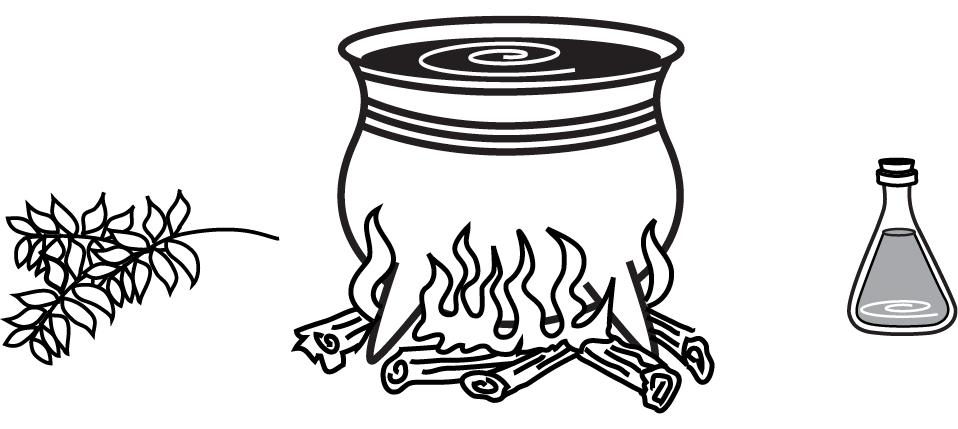Potion Class:
Creating Herbal Brews,
Raw Incense, Magical
Oils, and Salves
Brewing
For centuries, brewing magical potions has been associated with witches. Far from being an unfair stereotype, we do occasionally light a fire (usually on a kitchen stove), pour fresh water into our cauldrons (or an enamel pot), and as the water warms and steam rises, drifting through the air, we throw magically charged herbs into the water and let the infusion mingle the essences of the herbs into one powerful concoction! Cackling is optional, of course.

The actual process of brewing a potion is not really that difficult as long as you follow the steps and have all the necessary tools and ingredients. As a general rule, you would add a total of one ounce (two tablespoons) of herbal mixture per cup of water unless otherwise indicated in the recipe. Prior to adding the herbs for the brew, they should be ground, mixed, and empowered with your magical goal for the finished product. The water is heated in the chosen vessel (a cauldron or cooking pot dedicated to brew making) until it nears the boiling point and begins to steam; then herbs are added and the pot is covered with a lid, removed from the high heat, and left to steep for ten to thirteen minutes. After the brew has steeped, it is usually strained and bottled for use. This is the basic brewing process and will be modified in some instances. Some brews, particularly those with roots and barks as ingredients, require that you boil the water and herbs covered in order to properly extract the essence. In other cases, there will not be an opportunity to strain the brew, such as when you’re brewing outdoors in a balefire; in that case, you will just have to carefully ladle out the brew into cups without straining. There are several brew recipes included in this book and any modifications that can be made are noted in the recipe. Brews should be made and immediately used. Their power diminishes greatly if they
are left out or refrigerated.
Note: None of the recipes are intended to treat or cure any illness or condition. I have used the brews successfully to relieve my own symptoms over the years, but am not suggesting them as a replacement to traditional medical care.
Making Incense
Making incense is another relatively easy process. Grind the chosen recipe of herbs in a pestle and mortar, combine them in a bowl, and add any required liquid ingredients. Then all you have to do is empower the incense with your intent and bottle it for future use. To use the incense, simply light a quick-light charcoal (the kind designed for incense rather than for barbeque), place it in a censer, and sprinkle a bit of incense on the glowing charcoal. Add more incense as needed.
Making Oil
In magic, a variety of herbal and flower oils can be used. A few types are pure essential oils taken directly from the plant, oil blends designed to mimic the scent of a specific herb or flower, or extracted scent oils made by soaking or heating plant substances in a base oil until the plant essences are extracted. This last type of oil is what I prefer to use for a few reasons. Making scented oil is much cheaper than purchasing essential oils, and essential oils have to be diluted with a base oil; in addition, I find homemade scented oils to be more magical in their function than their purchased counterparts because scented oils require a bit more personal effort to create.
Making scented oils is pretty easy. You will need a pot, bottle, spoon, base oil, herbal ingredients, and a sieve to strain the finished oil. A base or carrier oil is relatively unscented oil that is used as the main ingredient in an oil recipe to extract and carry the scents and energies of the other ingredients. Frequently, vegetable (soy) oil is used as a carrier oil as are olive and jojoba oils, the latter being more of a liquefied wax than an actual oil. I prefer soy oil in most of my work, except for where olive oil is specifically called for in a recipe.
The basic formula for oils is four tablespoons of herbs to a half cup of base oil (vegetable or soy oil, olive oil, jojoba oil, sunflower oil, or grape seed oil are a few). You then pour the oil into a pot dedicated to this purpose (don’t use the pot for food), mix in the herbs, and heat over very low heat, stirring constantly until the scent of the oil fills the air. Now, remove from heat, put the lid on the pot, and let the oil cool for half an hour. Once the oil has cooled, strain, bottle, and empower the oil with your intent. If the scent is not strong enough, you can reuse the same oil, adding fresh herbs and repeating the simmering process until the scent is strong enough. After the oil is complete, label the bottle and refrigerate.
Making Salves
The process of making herbal salves or ointments is not that complicated. It is essentially the same process as making scented magical oils except you use lard or vegetable shortening as your base instead of using liquid oil. First, grind and mix the chosen herbs. Next, slowly melt the shortening over LOW heat and stir in the herbs. Keep stirring until the scent of the herbs fills the air. When you can smell the herbs, remove the pot from the stove, let it cool slightly, and pour the liquid (carefully!) through a metal sieve and into a heatproof container. Allow the ointment to cool, and refrigerate when not in use. Ointments have minimal shelf life (about 3 days) and should only be made in small amounts when needed.